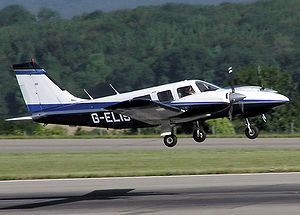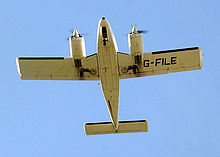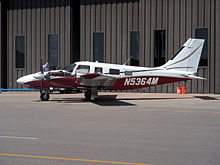Piper PA-34 Seneca Video - Picture

|
|
Piper PA-34 Seneca

Picture - Piper PA-34-200T Seneca II
Role: business and personal aircraft
Manufacturer: Piper Aircraft
First flight: 25 April 1967
Introduced: 1971
Status: In production
Unit cost: USD$799,000 (2009 base price)
Variants: PZL M-20 Mewa

Picture - Piper Seneca
The Piper PA-34 Seneca is an American twin-engined light aircraft, produced by Piper Aircraft since 1971 and still in production in 2009.
The Seneca is primarily used for personal and business flying.
Development
The Seneca was developed as a twin-engine version of the Piper Cherokee Six. The prototype was a Cherokee Six that had wing-mounted engines installed, retaining its nose engine. The prototype was flown as a tri-motor aircraft in the initial stages of the test-flying program.
PA-34-180 Twin Six

Picture - Seneca V
With the decision to abandon the three-engined design tested on the PA-32-3M the PA-34 was developed as a twin-engined design. The prototype PA-34-180 Twin Six, registered N3401K first flew on 25 April 1967. The prototype had two 180 hp (134 kW) Lycoming O-360 engines, a fixed nosewheel landing gear and a Cherokee Six vertical tail. The second prototype flew on 30 August 1968, still with the 180 hp (134 kW) Lycomings but had retractable landing gear and a taller vertical tail. During development flying the wingspan was increased by two feet. The third prototype closer to the production standard flew on 20 October 1969, it was fitted with 200 hp (149 kW) Lycoming IO-360-A1A engines.
PA-34-200 Seneca I

Picture - Piper Seneca with engine cowl removed
Certified on 7 May 1971 and introduced in late 1971 as a 1972 model, the PA-34-200 Seneca I, is powered by pair of Lycoming IO-360-C1E6 engines. The righthand engine is a Lycoming LIO-360-C1E6 engine variant, the "L" in its designation indicating that the crankshaft turns in the opposite direction, giving the Seneca I counter-rotating engines. The counter-rotating engines eliminate the critical engine limitations of other light twins and make the aircraft more controllable in the event of a shut down or failure of either engine. A total of 934 Seneca Is were built, including one prototype.
The early Seneca Is have a maximum gross weight of 4,000 lb (1,810 kg), while later serial numbers allowed a take-off weight of 4,200 lb (1,910 kg).
PA-34-200T Seneca II
Responding to complaints about the aircraft's handling qualities, Piper introduced the PA-34-200T Seneca II. The aircraft was certified on July 18, 1974 and introduced as a 1975 model.
The new model incorporated changes to the aircraft's control surfaces, including enlarged and balanced ailerons, the addition of a rudder anti-servo tab, and a stabilator bobweight.
The "T" in the new model designation reflected a change to turbocharged, six cylinder Continental TSIO-360E or EB engines for improved performance, particularly at higher altitudes. The Seneca II retained the counter-rotating engine arrangement of the earlier Seneca I.
The Seneca II also introduced optional "club seating" whereby the two center-row seats face rearwards and the two back seats face forward allowing more legroom in the passenger cabin. A total of 2,588 Seneca IIs were built.
Gross weights are 4,570 lb (2,070 kg) for takeoff and 4,342 lb (1,969 kg) for landing, with all weight in excess of 4,000 lb (1,800 kg) required to be fuel.
PA-34-220T Seneca III
In 1981, the PA-34-220T Seneca III was introduced, having completed certification on December 17, 1980.
The change in model designation reflected an engine upgrade. Continental TSIO-360-KB engines were used which produced 220 horsepower (165 kW), although only rated as such for five minutes and then dropping to 200 hp (149 kW)).
The horsepower increase, with the new engines' limit of 2800 rpm (up from 2575 rpm), combined for much improved climb and cruise performance. The new aircraft also incorporated a one piece windshield and a bare metal instrument panel instead of one covered with a removable plastic fascia; and some models have electrically-actuated flaps. More than 930 Seneca IIIs were built; the last 37 Seneca IIIs built had a 28-volt electrical system rather than the 14-volt system of previous aircraft.
The aircraft's gross weight was increased to 4,570 lb (2,073 kg) for takeoff and 4,513 lb (2,047 kg) for landing.
PA-34-220T Seneca IV
In 1994, the "New" Piper Aircraft company introduced the Seneca IV, having achieved certification on November 17, 1993. This model was similar to the Seneca III offering minor improvements, such as a streamlined engine cowl for increased cruise performance. It continued to use the counter-rotating Continental TSIO-360-KB engines and gross weights remained unchanged. A total of 71 Seneca IVs were built.
PA-34-220T Seneca V
Certified on December 11, 1996, the Seneca V was put into production as a 1998 model year. Again the cowls were redesigned for increased performance, several cockpit switches were relocated from the panel to the headliner and a slightly different engine variant, the Continental TSIO-360-RB was installed.
The Seneca V's gross weights remain the same as the Seneca III and IV at 4,570 lb (2,073 kg) for takeoff and 4,513 lb (2,047 kg) for landing.
Embraer EMB-810 Seneca
From 1975 the Seneca was built under licence in Brazil by Embraer as the EMB-810. The PA-34-200T as the EMB-810C Seneca (452 built) and the PA-34-220T as the EMB-810D (228 built).
Operators
Civil
The aircraft is popular with air charter companies and small feeder airlines, and is operated by private individuals and companies. One notable civil operator is the Costa Rican Air Surveillance Service.
Military
Brazil
Brazilian Air Force (EMB 810C Seneca)
Burkina Faso Dominican Republic
Dominican Air Force
Haiti
Armed Forces of Haiti
Panama
Panamanian Public Forces
Specifications (PA-34-220T Seneca V)
Data from Piper Seneca V Information Manual (October 25, 2005)
General characteristics
Crew: One
Capacity: Five or six passengers
Length: 28 ft 7.44 in (8.72 m)
Wingspan: 38 ft 10.87 in (11.86 m)
Height: 9 ft 10.8 in (3.02 m)
Wing area: 208.7 ft² (19.39 m²)
Airfoil: laminar flow NACA 652-415
Empty weight: 3212 lb (1457 kg)
Loaded weight: 4773 lb (2165 kg)
Useful load: 993 lb (450 kg)
Max takeoff weight: 4750 lb (2155 kg)
Powerplant: 2 x— Continental TSIO-360RB and LTSIO-360RB 6-cylinder, air-cooled, horizontally-opposed piston engine, 220 hp (164 kW) each
Performance
Never exceed speed: 204 knots (378 km/h, 235 mph)
Maximum speed: 204 knots (378 km/h, 235 mph) at 23,000 ft (7,000 m)
Cruise speed: 188 knots (348 km/h, 216 mph) econ cruise at 25,000 ft (7,600 m)
Stall speed: 61 knots (113 km/h, 70 mph) wheels and flaps down
Range: 870 nmi (1611 km, 1000 mi) max fuel, econ cruise at 18,000 ft (5,500 m), no reserves
Service ceiling: 25,000 ft (7,620 m)
Rate of climb: 1550 ft/min (7.87 m/s)
Wing loading: 21.2 lb/ft² (104 kg/m²)
Power/mass: 0.1 hp/lb (164 W/kg)
Related development
PZL M-20 Mewa
Embraer EMB 810 Seneca
Comparable aircraft
Beechcraft Baron
Cessna 310
English, Adrian J. "Air Power Analysis:Central America and the Caribbean:Panama". World Air Power Journal, Volume 32 Spring 1998. London:Aerospace Publishing. pp. 142-157. ISBN 1 86184 006 3. ISSN 0959-7050.
Peperell, Roger W; Smith, Colin M (1987). Piper Aircraft and their forerunners. Tonbridge, Kent, England: Air-Britain. ISBN 0 85130 149 5.
Taylor, John W.R. Jane's All The World's Aircraft 1976-77. London:Jane's Yearbooks, 1976, ISBN 0 354 00538 3.
The New Piper Aircraft, Inc. Piper PA-34-200 Seneca Airplane Service Manual; Manual Part Number 753-817, dated October 30, 2003.
"World's Air Forces 1988".Flight International, 3 December 1988. pp. 22-87.
Piper PA-34 Seneca Pictures
More airplane videos.
Source: WikiPedia